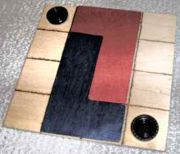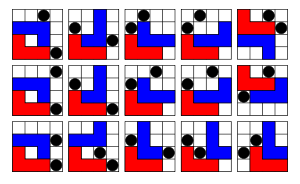
L game
Encyclopedia


Strategy game
A strategy game or strategic game is a game in which the players' uncoerced, and often autonomous decision-making skills have a high significance in determining the outcome...
invented by Edward de Bono
Edward de Bono
Edward de Bono is a physician, author, inventor, and consultant. He originated the term lateral thinking, wrote a best selling book Six Thinking Hats and is a proponent of the deliberate teaching of thinking as a subject in schools.- Biography :Edward Charles Francis Publius de Bono was born to...
.
The L game is a two-player turn-based game played on a board of 4×4 squares. Each player has a 3×2 L-shaped piece, and there are two 1×1 neutral pieces. On each turn, a player first must move their L piece, and then may elect to move one of the single neutral pieces. Pieces cannot overlap or cover other pieces. On moving the L piece it is picked up then placed in empty squares anywhere on the board and the piece may be rotated or even flipped over in doing so, the only rule is it must be in a different position than the one it was picked up from, thus come to rest covering at least one grid square that it was not previously covering. On moving a neutral piece, which is optional, a player simply picks it up then places it in any empty square anywhere on the board (even the same square, although this is the same as not moving it). The loser is the first player unable to move their L piece to a new position.
One basic strategy is to use a neutral piece and one's own piece to block a 3×3 square in one corner, and use a neutral piece to prevent the opponent's L piece from swapping to a mirror-image position. Another basic strategy
Strategy
Strategy, a word of military origin, refers to a plan of action designed to achieve a particular goal. In military usage strategy is distinct from tactics, which are concerned with the conduct of an engagement, while strategy is concerned with how different engagements are linked...
is to move an L piece to block a half of the board, and use the neutral pieces to prevent the opponent's possible alternate positions.
These positions can often be achieved once a neutral piece is left in one of the eight killer spaces on the perimeter of the board. The killer spaces are the spaces on the perimeter, but not in a corner. On the next move, one either makes the previously placed killer a part of one's square, or uses it to block a perimeter position, and makes a square or half-board block with one's own L and a moved neutral piece.
Analysis

Even if neither player plays perfectly, defensive play can continue indefinitely if the players are too cautious to move a neutral piece to the killer positions. If both players are at this level, a sudden-death variant of the rules permits one to move both neutral pieces after moving. A player who can look three moves ahead can defeat defensive play using the standard rules.

